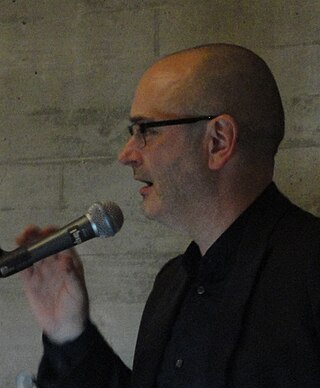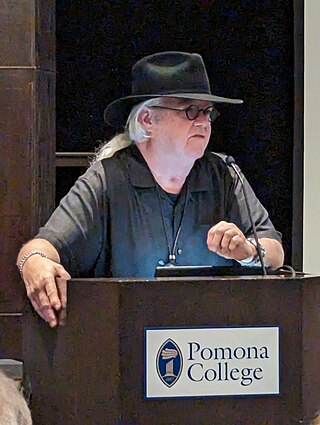
Frank Owen Gehry is a Canadian-born American architect and designer. A number of his buildings, including his private residence in Santa Monica, California, have become world-renowned attractions.

Marguerite "Peggy" Guggenheim was an American art collector, bohemian, and socialite. Born to the wealthy New York City Guggenheim family, she was the daughter of Benjamin Guggenheim, who went down with the Titanic in 1912, and the niece of Solomon R. Guggenheim, who established the Solomon R. Guggenheim Foundation. Guggenheim collected art in Europe and America between 1938 and 1946. She exhibited this collection as she built it. In 1949, she settled in Venice, where she lived and exhibited her collection for the rest of her life. The Peggy Guggenheim Collection is a modern art museum on the Grand Canal in Venice, Italy, and is one of the most visited attractions in Venice.

Douglas Gordon is a Scottish artist. He won the Turner Prize in 1996, the Premio 2000 at the 47th Venice Biennale in 1997 and the Hugo Boss Prize in 1998. He lives and works in Berlin, Germany.

Alexander Porfyrovych Archipenko was a Ukrainian-American avant-garde artist, sculptor, and graphic artist, active in France and the United States. He was one of the first to apply the principles of Cubism to architecture, analyzing human figure into geometrical forms.

John Angus Chamberlain, was an American sculptor and filmmaker. At the time of his death he resided and worked on Shelter Island, New York.

Joan Jonas is an American visual artist and a pioneer of video and performance art, and one of the most important artists to emerge in the late 1960s and early 1970s. Jonas' projects and experiments were influential in the creation of video performance art as a medium. Her influences also extended to conceptual art, theatre, performance art and other visual media. She lives and works in New York and Nova Scotia, Canada.
Larry Bell is an American contemporary artist and sculptor. He is best known for his glass boxes and large-scaled illusionistic sculptures. He is a grant recipient from, among others, the National Endowment for the Arts and the Guggenheim Foundation, and his artworks are found in the collections of many major cultural institutions. He lives and works in Taos, New Mexico, and maintains a studio in Venice, California.
Charles Arnoldi, also known as Chuck Arnoldi and Charles Arthur Arnoldi, is an American painter, sculptor and printmaker. He was born April 10, 1946, in Dayton, Ohio.

Peter Shelton is a contemporary American sculptor born in 1951 in Troy, Ohio.
Peter Ford Young is an American painter. He is primarily known for his abstract paintings that have been widely exhibited in the United States and in Europe since the 1960s. His work is associated with Minimal Art, Post-minimalism, and Lyrical Abstraction. Young has participated in more than a hundred group exhibitions and he has had more than forty solo exhibitions in important contemporary art galleries throughout his career. He currently lives in Bisbee, Arizona.
Bryan Hunt is an American sculptor who was born in Terre Haute, Indiana on June 7, 1947. His family moved to Tampa, Florida in 1955. He worked at the Kennedy Space Center as an engineer's aide and draftsman, 1967–1968, during the NASA Apollo Program. In 1968, he moved to Los Angeles to enroll in the Otis Art Institute, where he received a BFA in 1971.

Light and Space denotes a loosely affiliated art movement related to op art, minimalism and geometric abstraction originating in Southern California in the 1960s and influenced by John McLaughlin. It is characterized by a focus on perceptual phenomena, such as light, volume and scale, and the use of materials such as glass, neon, fluorescent lights, resin and cast acrylic, often forming installations conditioned by the work's surroundings. Whether by directing the flow of natural light, embedding artificial light within objects or architecture, or by playing with light through the use of transparent, translucent or reflective materials, Light and Space artists make the spectator's experience of light and other sensory phenomena under specific conditions the focus of their work. From the movement's inception, artists were incorporating into their work the latest technologies of the Southern California-based engineering and aerospace industries to develop sensuous, light-filled objects. Turrell, who has spread the movement worldwide, summed up its philosophy in saying, "We eat light, drink it in through our skins."

Claire Falkenstein was an American sculptor, painter, printmaker, jewelry designer, and teacher, most renowned for her often large-scale abstract metal and glass public sculptures. Falkenstein was one of America's most experimental and productive 20th-century artists.
Laura Owens is an American painter, gallery owner and educator. She emerged in the late 1990s from the Los Angeles art scene. She is known for large-scale paintings that combine a variety of art historical references and painterly techniques. She lives and works in Los Angeles, California.
The year 2013 in art involves some significant events.

Senga Nengudi is an African-American visual artist and curator. She is best known for her abstract sculptures that combine found objects and choreographed performance. She is part of a group of African-American avant-garde artists working in New York City and Los Angeles, from the 1960s and onward.

Anthony Hanna Berlant is an American artist who was born in New York City. He attended the University of California, Los Angeles, where he received a BA (1961) and MA (1962) in painting and an MFA (1963) in sculpture. He has a large collection of Southwestern Native American art, especially Mimbres pottery and Navajo rugs. He lives and works in Santa Monica, California.

Michael Leslie Brewster was an American artist, recognized for coining the term “acoustic sculpture.” He worked with sound to create sonic environments beginning in the 1970s until 2016. His works were shown across the United States and Europe, and are in permanent collections, notably the Solomon Guggenheim Museum, the Fondo per Arte Italiano, Museum of Contemporary Art Los Angeles, and the Giuseppe Panza Collection.
Laddie John Dill is an American artist. Dill calls his work "light sentences". Dill received a BFA degree from Chouinard Art Institute, Los Angeles, in 1968. He is the older brother of sculptor Guy Dill.











